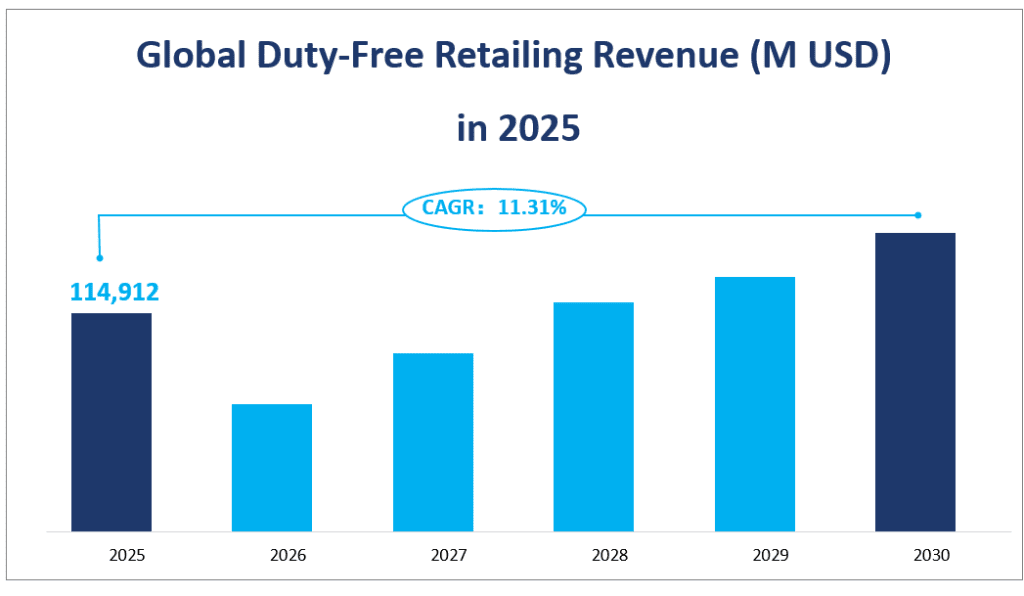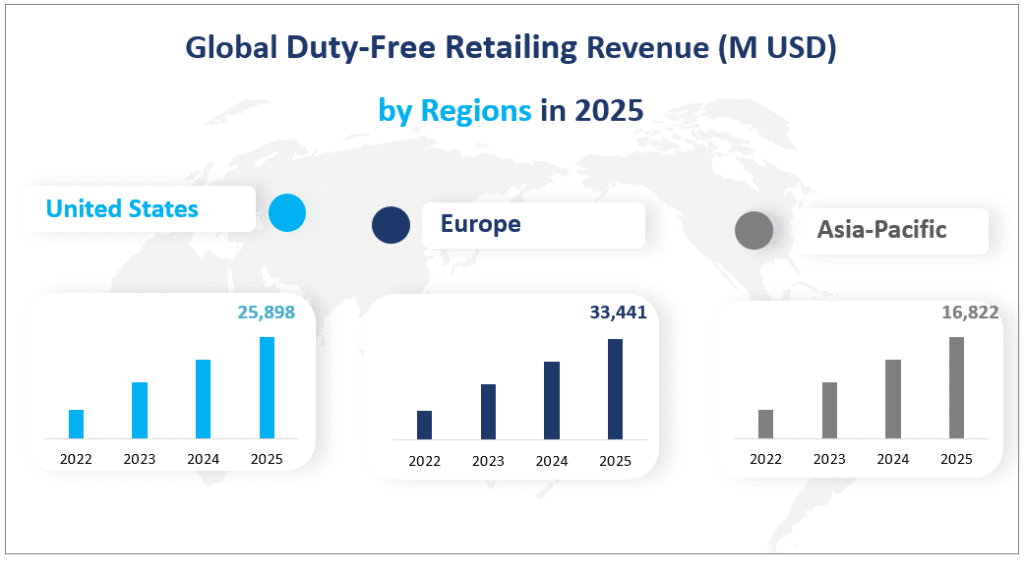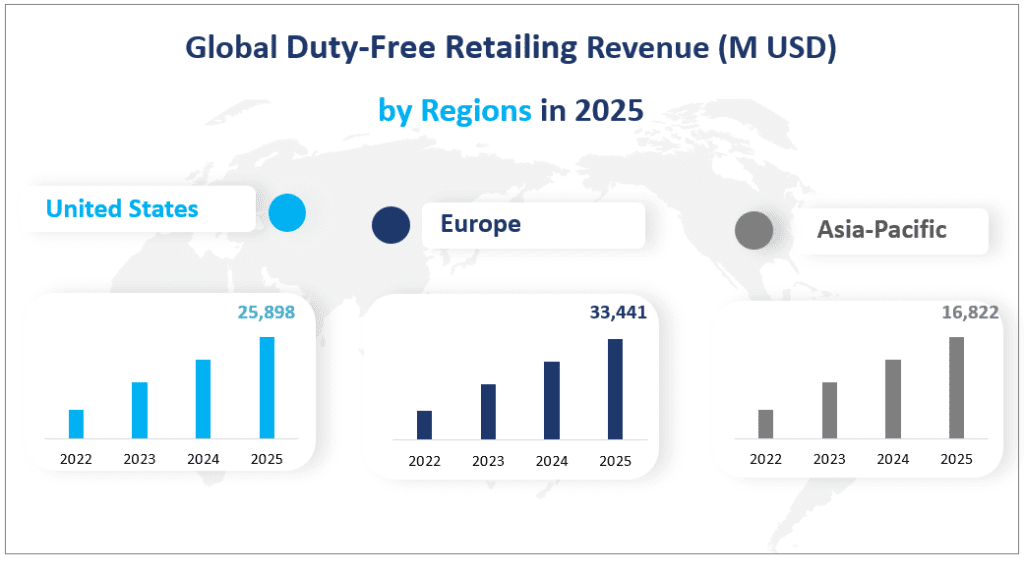1. Global Duty-Free Retailing Market Value and CAGR
The global duty-free retailing market is a significant segment of the travel retail industry, catering to international travelers through a variety of channels including airports, seaports, train stations, and downtown duty-free shops. The global duty-free retailing market is projected to reach a value of $114,912 million by 2025 with a CAGR of 11.31% from 2025 to 2030.
Duty-free retailing market is defined as the sale of goods to international travelers without the imposition of customs duties and taxes. These products are typically sold in highly regulated environments, such as airports, cruise ships, and border crossings. The duty-free retailing industry operates under strict customs regulations, which vary by country and region. The primary appeal of duty-free shopping lies in the tax advantages and the availability of exclusive products that are not available in regular retail stores.
Global Duty-Free Retailing Market Revenue (M USD) in 2025


2. Driving Factors of Duty-Free Retailing Market
The primary drivers of market expansion include the increasing number of international travelers, rising disposable incomes, and the growth of the tourism industry. The Asia-Pacific region, in particular, has seen significant growth in duty-free retailing, driven by the expanding Chinese middle class and the increasing popularity of travel destinations such as Japan, South Korea, and Southeast Asia.
Another significant driver of the duty-free retailing market is the expansion of sales channels. The introduction of online shopping platforms has allowed duty-free retailers to reach a broader audience, including domestic travelers and those who prefer the convenience of shopping from home. This trend has been accelerated by the COVID-19 pandemic, which has led to a shift towards e-commerce and digital retailing.
3. Limiting Factors of Duty-Free Retailing Market
However, the duty-free retailing market also faces several limiting factors. One of the most significant challenges is the impact of global economic and political events. The COVID-19 pandemic, for example, led to a sharp decline in international travel and a corresponding drop in duty-free sales. Other limiting factors include changes in customs regulations, increased competition from domestic retail markets, and the impact of natural disasters and geopolitical tensions.
Another challenge for the duty-free retailing market is the high degree of regulation and the need to comply with customs laws and regulations in different countries. This can create operational complexities and increase costs for retailers. Additionally, the industry is highly dependent on the health of the global travel and tourism industry, which can be volatile and subject to sudden changes.
4. Global Duty-Free Retailing Market Segment
Product Types
Perfumes are a significant segment within the duty-free retailing market, known for their high demand among travelers. By 2025, the market value for perfumes is expected to reach $20,243 million. This category includes a wide range of products from luxury brands to more affordable options, catering to diverse consumer preferences.
Cosmetics represent another major product type in the duty-free retailing market. By 2025, the cosmetics segment is projected to achieve a market value of $20,698 million. This category includes skincare, makeup, and personal care products, often sold at discounted prices compared to regular retail stores.
Alcohol is a popular product type in duty-free retailing market, with a projected market value of $19,900 million by 2025. This segment includes a wide range of alcoholic beverages, from spirits and wines to beers, catering to the preferences of travelers seeking tax-free purchases.
Cigarettes are another key product type in the duty-free retailing market, with a projected market value of $12,641 million by 2025. This category includes a variety of tobacco products, often sold at discounted prices compared to regular retail stores.
The “other products” category includes a diverse range of items such as electronics, accessories, and luxury goods. By 2025, this segment is projected to achieve a market value of $41,431 million. This category has the largest market share due to its broad range of products and the high demand for luxury items among travelers.
Analysis of Duty-Free Retailing Applications
Airports represent the largest application segment in the duty-free retailing market, with a projected market value of $92,331 million by 2025. This segment includes duty-free stores located within airport terminals, catering to travelers before and after their flights.
Onboard aircraft duty-free retailing marekt is another significant application segment, with a projected market value of $4,494 million by 2025. This segment includes in-flight sales of duty-free products, often targeting premium travelers.
Seaports represent a smaller but growing segment in the duty-free retailing market, with a projected market value of $4,791 million by 2025. This segment includes duty-free stores located at seaports and ferry terminals, catering to travelers on cruise ships and ferries.
Train stations represent another application segment in the duty-free retailing market, with a projected market value of $9,701 million by 2025. This segment includes duty-free stores located at major train stations, catering to travelers on international rail journeys.
The “other applications” category includes a diverse range of retail channels, such as downtown duty-free stores and online platforms. By 2025, this segment is projected to achieve a market value of $3,595 million. This category has the smallest market share but is growing rapidly due to the expansion of e-commerce and the increasing popularity of online shopping among travelers.
Among the various applications, airports hold the largest market share. This segment is the primary channel for duty-free sales, driven by the high volume of international travelers and the strategic placement of retail stores within airport terminals. In terms of growth rate, the train station segment is projected to grow at the fastest pace, with an annual growth rate of 11.80%. This reflects the increasing demand for duty-free products among rail travelers and the expansion of duty-free retail infrastructure at major train stations.
Market Value by Segment
| Market Value (M USD) in 2025 | ||
| By Type | Perfumes | 20243 |
| Cosmetics | 20698 | |
| Alcohol | 19900 | |
| Cigarettes | 12641 | |
| By Application | Airports | 92331 |
| Onboard Aircraft | 4494 | |
| Seaports | 4791 | |
| Train Stations | 9701 |
5. Regional Duty-Free Retailing Market
Europe remains a dominant player in the global duty-free retailing market, with a projected market value of $33,441 million by 2025. Europe’s robust market is driven by its extensive network of international airports, high tourist traffic, and the presence of luxury brands. Key markets within Europe include the United Kingdom, France, Germany, Italy, and Spain. The growth rate for Europe is estimated at 8.84% annually, reflecting the region’s strong economic fundamentals and the resilience of its travel and tourism industry.
The Asia-Pacific region is emerging as a powerhouse in the duty-free retailing market, with a projected market value of $16,822 million by 2025. This region’s growth is fueled by the increasing number of international travelers, particularly from China, as well as the expansion of duty-free retail channels in key markets such as Japan, South Korea, and Southeast Asia. The region’s appeal is further enhanced by its strategic location and the growing middle class, which drives demand for luxury goods.
The United States is a significant market for duty-free retailing market, with a projected market value of $25,898 million by 2025. The U.S. market benefits from a large number of international travelers, particularly those passing through major airports such as New York, Los Angeles, and Miami. Japan is a key market within the Asia-Pacific region, with a projected market value of $13,750 million by 2025. Japan’s duty-free retailing market is characterized by its high-end luxury goods and a strong domestic demand for international brands.
The fastest-growing region is also the Asia-Pacific region. This rapid growth is attributed to the region’s strong economic fundamentals, the increasing middle class, and the expanding travel and tourism industry.
Global Duty-Free Retailing Market Revenue (M USD) by Regions in 2025


6. Analysis of the Top 3 Companies in the Duty-Free Retailing Market
Lotte Duty Free is a leading player in the global duty-free retailing market, with a strong presence in Asia and beyond. Established in 1980, Lotte Duty Free is part of the Lotte Group, one of South Korea’s largest retail conglomerates. The company operates a network of duty-free stores in key locations, including airports, downtown areas, and cruise ships. Lotte Duty Free is known for its wide range of luxury brands and its innovative retail strategies.
Lotte Duty Free offers a diverse range of products, including perfumes, cosmetics, alcohol, cigarettes, and luxury goods. The company is particularly strong in the cosmetics and perfume segments, catering to the high demand for luxury brands among international travelers.
The Shilla Duty Free is a prominent player in the global duty-free retailing market, with a strong focus on luxury cosmetics and perfumes. Established in 1986, The Shilla Duty Free operates a network of duty-free stores in key airports and downtown areas across Asia. The company is known for its high-end retail experience and its commitment to customer service.
The Shilla Duty Free offers a wide range of products, including luxury cosmetics, perfumes, alcohol, and cigarettes. The company is particularly strong in the cosmetics segment, catering to the high demand for luxury brands among international travelers.
China Duty-Free Group (CDFG) is a leading player in the global duty-free retailing market, with a strong presence in China and the Asia-Pacific region. Established in 1984, CDFG is a state-owned enterprise authorized to operate duty-free businesses across China. The company operates a network of duty-free stores in key airports and downtown areas, catering to the growing number of international travelers.
China Duty Free Group offers a diverse range of products, including perfumes, cosmetics, alcohol, cigarettes, and luxury goods. The company is particularly strong in the cosmetics and perfume segments, catering to the high demand for luxury brands among international travelers.
Major Players
| Company Name | Headquarters | Market Distribution |
| Lotte Duty Free | Seoul, South Korea | Mainly in Asia Pacific |
| The Shilla Duty Free | Seoul, South Korea | Mainly in Asia Pacific |
| China Duty Free Group | Beijing, China | Mainly in Asia Pacific |
| Dufry | Basel, Switzerland | Worldwide |
| DFS Group | Hong Kong | Worldwide |
| Gebr. Heinemann | Hamburg, Germany | Worldwide |
| Shinsegae Duty Free | Seoul, South Korea | Mainly in South Korea |
| The King Power International Group | Bangkok, Thailand | Mainly in Thailand |
| Ever Rich Duty Free | Taiwan | Mainly in Taiwan |
| Dubai Duty Free | Dubai, UAE | Mainly in Dubai |
| Lagardère Group | Paris, France | Worldwide |
1 Market Overview
1.1 Duty Free Retailing Introduction
1.2 Market Analysis by Types
1.3 Market Analysis by Application
1.4 Market Analysis by Regions
1.4.1 United States Market States and Outlook (2015-2027)
1.4.2 Europe Market States and Outlook (2015-2027)
1.4.3 China Market States and Outlook (2015-2027)
1.4.4 Japan Market States and Outlook (2015-2027)
1.4.5 Southeast Asia Market States and Outlook (2015-2027)
1.4.6 India Market States and Outlook (2015-2027)
1.4.7 Brazil Market States and Outlook (2015-2027)
1.4.8 GCC Countries Market States and Outlook (2015-2027)
1.5 Market Dynamics and Development
1.5.1 Merger, Acquisition and New Investment
1.5.2 Market SWOT Analysis
1.5.3 Drivers
1.5.4 Limitations
1.5.5 Opportunities and Development Trends
1.6 Global Duty Free Retailing Market Size Analysis from 2015 to 2027
2 Global Duty Free Retailing Competition by Types, Applications, and Top Regions and Countries
2.1 Global Duty Free Retailing Value by Type
2.2 Global Duty Free Retailing Value by Application
2.3 Global Duty Free Retailing Value by Regions
3 United States Duty Free Retailing Market Analysis
3.1 United States Duty Free Retailing Value Analysis
3.2 United States Duty Free Retailing Value by Types
3.3 United States Duty Free Retailing Value by Application
4 Europe Duty Free Retailing Market Analysis
4.1 Europe Duty Free Retailing Value Analysis
4.2 Europe Duty Free Retailing Value by Types
4.3 Europe Duty Free Retailing Value by Application
4.4 Europe Duty Free Retailing Value by Top Countries
4.4.1 Germany Duty Free Retailing Value (M USD) from 2015 to 2020
4.4.2 UK Duty Free Retailing Value (M USD) from 2015 to 2020
4.4.3 France Duty Free Retailing Value (M USD) from 2015 to 2020
4.4.4 Italy Duty Free Retailing Value (M USD) from 2015 to 2020
4.4.5 Spain Duty Free Retailing Value (M USD) from 2015 to 2020
4.4.6 Poland Duty Free Retailing Value (M USD) from 2015 to 2020
4.4.7 Russia Duty Free Retailing Value (M USD) from 2015 to 2020
5 China Duty Free Retailing Market Analysis
5.1 China Duty Free Retailing Value Analysis
5.2 China Duty Free Retailing Value by Types
5.3 China Duty Free Retailing Value by Application
5.4 China Duty Free Retailing Market Under COVID-19
6 Japan Duty Free Retailing Market Analysis
6.1 Japan Duty Free Retailing Value Analysis
6.2 Japan Duty Free Retailing Value by Types
6.3 Japan Duty Free Retailing Value by Application
6.4 Japan Duty Free Retailing Market Under COVID-19
7 Southeast Asia Duty Free Retailing Market Analysis
7.1 Southeast Asia Duty Free Retailing Value Analysis
7.2 Southeast Asia Duty Free Retailing Value by Types
7.3 Southeast Asia Duty Free Retailing Value by Application
7.4 Southeast Asia Duty Free Retailing Value by Top Countries
7.4.1 Indonesia Duty Free Retailing Value (M USD) from 2015 to 2020
7.4.2 Thailand Duty Free Retailing Value (M USD) from 2015 to 2020
7.4.3 Philippines Duty Free Retailing Value (M USD) from 2015 to 2020
7.4.4 Malaysia Duty Free Retailing Value (M USD) from 2015 to 2020
7.4.5 Singapore Duty Free Retailing Value (M USD) from 2015 to 2020
7.4.6 Vietnam Duty Free Retailing Value (M USD) from 2015 to 2020
7.5 Southeast Asia Duty Free Retailing Market Under COVID-19
8 India Duty Free Retailing Market Analysis
8.1 India Duty Free Retailing Value Analysis
8.2 India Duty Free Retailing Value by Types
8.3 India Duty Free Retailing Value by Application
8.4 India Duty Free Retailing Market Under COVID-19
9 Brazil Duty Free Retailing Market Analysis
9.1 Brazil Duty Free Retailing Value Analysis
9.2 Brazil Duty Free Retailing Value by Types
9.3 Brazil Duty Free Retailing Value by Application
9.4 Brazil Duty Free Retailing Market Under COVID-19
10 GCC Countries Duty Free Retailing Market Analysis
10.1 GCC Countries Duty Free Retailing Value Analysis
10.2 GCC Countries Duty Free Retailing Value by Types
10.3 GCC Countries Duty Free Retailing Value by Application
10.4 GCC Countries Duty Free Retailing Value by Major Countries
10.4.1 Saudi Arabia Duty Free Retailing Value from 2015 to 2020
10.4.2 United Arab Emirates Duty Free Retailing Value from 2015 to 2020
10.4.3 Qatar Duty Free Retailing Value from 2015 to 2020
10.4.4 Bahrain Duty Free Retailing Value from 2015 to 2020
11 Providers Profiles
11.1 Lotte Duty Free
11.1.1 Business Overview
11.1.2 Products Analysis
11.1.3 Lotte Duty Free Duty Free Retailing Value, Gross and Gross Margin
11.2 The Shilla Duty Free
11.2.1 Business Overview
11.2.2 Products Analysis
11.2.3 The Shilla Duty Free Duty Free Retailing Value, Gross and Gross Margin
11.3 China Duty Free Group
11.3.1 Business Overview
11.3.2 Products Analysis
11.3.3 China Duty Free Group Duty Free Retailing Value, Gross and Gross Margin
11.4 Dufry
11.4.1 Business Overview
11.4.2 Products Analysis
11.4.3 Dufry Duty Free Retailing Value, Gross and Gross Margin
11.5 DFS Group
11.5.1 Business Overview
11.5.2 Products Analysis
11.5.3 DFS Group Duty Free Retailing Value, Gross and Gross Margin
11.6 Gebr. Heinemann
11.6.1 Business Overview
11.6.2 Products Analysis
11.6.3 Gebr. Heinemann Duty Free Retailing Value, Gross and Gross Margin
11.7 Shinsegae Duty Free
11.7.1 Business Overview
11.7.2 Products Analysis
11.7.3 Shinsegae Duty Free Duty Free Retailing Value, Gross and Gross Margin
11.8 The King Power International Group
11.8.1 Business Overview
11.8.2 Products Analysis
11.8.3 The King Power International Group Duty Free Retailing Value, Gross and Gross Margin
11.9 Ever Rich Duty Free
11.9.1 Business Overview
11.9.2 Products Analysis
11.9.3 Ever Rich Duty Free Duty Free Retailing Value, Gross and Gross Margin
11.10 Dubai Duty Free
11.10.1 Business Overview
11.10.2 Products Analysis
11.10.3 Dubai Duty Free Duty Free Retailing Value, Gross and Gross Margin
11.11 Lagardère Group
11.11.1 Business Overview
11.11.2 Products Analysis
11.11.3 Lagardère Group Duty Free Retailing Value, Gross and Gross Margin
12 Marketing Strategy Analysis
12.1 Marketing Channel
12.1.1 Marketing Channel
12.1.2 Marketing Channel Development Trend
12.2 Market Positioning
12.2.1 Pricing Strategy
12.2.2 Brand Strategy
12.2.3 Target Client
13 Global Duty Free Retailing Market Forecast (2020-2027)
13.1 Global Duty Free Retailing Value Forecast (2020-2027)
13.2 Global Duty Free Retailing Value Forecast by Region (2020-2027)
13.3 Global Duty Free Retailing Value Forecast by Type (2020-2027)
13.4 Global Duty Free Retailing Value Forecast by Application (2020-2027)
13.5 Duty Free Retailing Market Forecast Under COVID-19
14 Research Conclusions
15 Appendix
15.1 Methodology
15.2 Research Data Source
